The value of a point is generally used in reference to redeeming points for free hotel nights. I will show how to compare point value when redeeming for hotel reward nights across programs (part 1) and then apply a similar methodology to show how to compare earning value from promotions across hotel loyalty programs (part 2). A case study of Hilton HHonors promotion offers in 2009 and 2010 is Part 3 to illustrate the promotion variable in practice through one major hotel loyalty program.
San Francisco Hotel Reward Comparison Across Hotel Loyalty Programs
Fisherman’s Wharf is a good place for cross program comparison due to an abundance of hotels from many different hotel chains that are all quite similar in hotel market segment and hotel size.
It is an easy calculation to take the room rate and divide by the number of points required for a free night at each hotel in each hotel loyalty program. The next step though requires a way to correlate the values to each other since these programs have different earn rates.
For example, Sheraton is part of Starwood Preferred Guest and SPG members earn 2 base points per dollar in hotel spend. It could take $5,000 in hotel spend to earn 10,000 SPG points.
But in real travel it takes far less than $5,000 in Starwood Hotels spend to earn 10,000 points due to promotion bonuses and the ability to earn far more than 2 points per dollar during your hotel stays. Â
The earning side of the equation is the part of hotel loyalty programs that needs better quantification.Â
I have made claims that Hilton HHonors is at a competitive disadvantage in terms of earning points for free nights. 2010 has been a great year for HHonors promotions, however, this program has been promotion weak for many years prior to 2010.Â
But how can I prove my claim in numbers to illustrate that HHonors has been promotion weak relative to other programs?
Marriott Rewards members earn 10 points per dollar in hotel spend, except when staying at Residence Inn and TownePlace Suites the earning rate drops to 5 points per dollar.
Earning variations make it more difficult to compare Hilton HHonors where hotel stays at any brand earn 10 points per dollar in hotel spend, but some members earn Points & Miles (10 points per dollar + airline miles) and other members have an earning preference of Points & Points (15 points per dollar) to a program like Marriott Rewards where members earn fewer points per dollar at some brands.
Equivalent Base Points Value – Methodology
I wrote a feature article for the April 2010 InsideFlyer magazine comparing hotel loyalty programs. One of my primary objectives was to come up with a way of comparing hotel reward value across programs that avoided the need to correlate hotel categories from one program to another.
For example in the slide showing San Francisco hotel categories you see Hilton Fisherman’s Wharf is a top-level category-7 hotel at 50,000 points for an HHonors reward night.
Hyatt Fisherman’s Wharf is a mid-tier category 3 hotel reward night at 12,000 points (note: Hyatt Fisherman’s Wharf  became a Gold Passport Category-4 hotel in June 2010 realignment of hotel rewards across six categories.)
Can I say a Hyatt Category-3 or Category-4 hotel is equivalent to a Hilton HHonors Category-3 or Category-4 hotel or a Category-7 hotel?
I wanted to avoid the “matching hotel reward categories” trap which is taken by most analyses comparing the value of hotel points in different programs.
Equivalent Base Points value seemed a step in the right direction for an authentic comparison of hotel loyalty program reward night value.
Â
Hotel Loyalty Program Base Points Earn Rates per US$1 hotel spend
- Carlson Hotels Goldpoints Plus = 20 base points per $1 (Country Inn and Park Inn = 15 points per $1)
- Hilton HHonors = 10 base points per $1 (15 points for Points & Points earners)
- Hyatt Gold Passport = 5 base points per $1
- InterContinental Hotels Group Priority Club = 10 base points per $1Â Â Â Â Â Â Â Â Â Â Â Â Â Â Â Â Â Â Â Â Â Â Â Â Â Â Â Â Â Â Â Â Â Â Â Â Â Â Â Â Â Â Â Â Â Â Â Â Â Â Â Â Â Â Â Â Â Â Â Â Â Â Â Â Â Â Â Â Â Â Â Â Â Â Â Â Â Â Â Â Â Â Â (IHG brands Staybridge Suites and Candlewood Suites = 5 points per $1)
- Marriott Rewards = 10 points per $1 (Residence Inn and TownePlace Suites = 5 points per $1)
- Starwood Preferred Guest = 2 points per $1
Since all base points earning programs use a fixed number of points per $1, I placed all these programs on an equivalent base points scale as shown in the slide below with a factor adjustment. This scale allowed me to compare the reward value of hotels in different programs by comparing the hotels using an equivalent base points value.
This is a basic methodology that can be refined for goldpoints plus, IHG Priority Club and Marriott Rewards to create a personal travel factor that is better aligned with your proportion of hotel spend occurring at the lower earning hotel brands. Hilton HHonors Points & Miles earners do not need an adjustment factor when earning 10 points per $1, but Hilton HHonors Points & Points earners adjust the earning rate by 1.5 to account for 15 points per dollar earned.
For example, the Marriott Rewards members with 50% annual hotel spend in Residence Inn will need to adjust the factor to account for average 7.5 base points per $1 rather than 10 points per $1 by Marriott Rewards member staying only in Marriott, Renaissance and Courtyard brands.
NerdWallet.com Methodology
To my surprise this summer I learned that the credit card rewards comparison and analysis online site NerdWallet.com had developed a similar methodology to Loyalty Traveler for evaluating the value of hotel points for co-branded hotel credit cards around the same time in early 2010.
Loyalty Traveler set point value in terms of a cash equivalent value.
NerdWallet.com took a more elegant approach in setting reward value in terms of the number of paid hotel nights needed to earn a free night at that hotel. This methodology basically calculates the number of points a member earns from a paid stay (base points earn rate and elite bonuses if applicable) and divides that into the reward night cost in points. The result is the number of nights you need to pay at a hotel to earn a free night in its loyalty program for that same hotel.
Here is how the NerdWallet.com methodology looks when applied to the San Francisco Fisherman’s Wharf hotels shown previously.
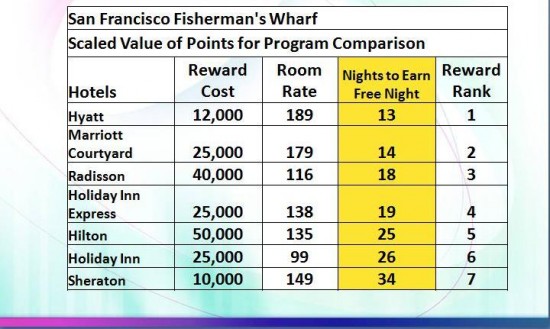
NerdWallet.com did this for many hotels in different brands and locations for each hotel loyalty program. They gathered a large sample of hotels which is what I actually advocated doing in my InsideFlyer article.
This methodology is quite similar to what I did in my InsideFlyer article but labeled in a different way. So I was confused when I saw the NerdWallet.com chart “The Value of Loyalty / Nights Required to Earn a Free Night” showing Marriott Rewards to be a very easy program for earning a free night (10 paid nights) and Priority Club being one of the hardest programs to earn a free night (25 paid nights).
Marriott Rewards did not surprise me since the program has a high proportion of hotels in its lowest reward categories. Much higher proportion than say Hilton or SPG.
The part I couldn’t believe was Priority Club ranking so low. I know from hundreds of anecdotes and my personal experience that in real travel Priority Club members are racking up free nights insanely fast.Â
Well, I was thrilled when Tim Chen, founder of NerdWallet.com responded to me personally to explain how their methodology created the Hotel Program Comparison chart.
And a couple of weeks later I really thought about the NerdWallet.com methodology as I studied Tim’s email and then I felt rather foolish when I realized NerdWallet.com had developed what appears to me to be a nearly identical mathematical construct for analyzing hotel reward value across programs. Their methodology also relies on equivalent base points value.
The next hurdle
There is still a problem with equivalent base points methodology because it relies too much on the free night redemption side of the process without accurately measuring the earning side of the equation.
Priority Club numbers are based on members earning 10 base points per dollar and whatever elite bonus points. Just like in my charts above for San Francisco the Priority Club hotel reward nights are not that great a value.
Loyalty traveler is fond of stating “Promotions make all the difference!”
And Priority Club has been the most clever hotel loyalty program in 2010 with its promotion activity.
I have seen numerous examples of members earning 30 to 50 points per dollar in hotel spend with Priority Club and my personal experiences match that. Comparing programs using just base points earning shortchanges the hotel programs where the majority of points earned are not base points earned from hotel spend.
Hyatt Gold Passport, Starwood Preferred Guest and  Priority Club are three programs where promotion bonus points will likely far exceed base points.
Promotions make all the difference when comparing the earn and burn value of points across hotel loyalty programs.
So how can promotions be factored into the equation?
I developed a basic Loyalty Traveler method for comparing hotel promotions across hotel loyalty programs using equivalent base points methodology. Â
The Promotion Variable in Hotel Loyalty Programs – Part Two
The Promotion Variable Part 3 – Hilton HHonors 2009-2010 Case Study


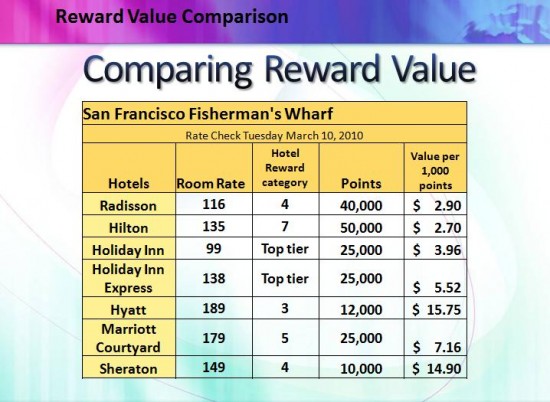
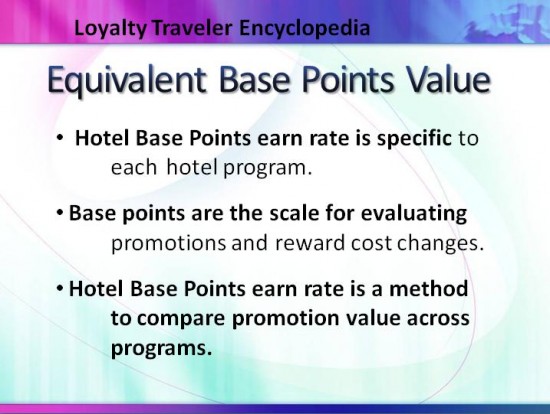
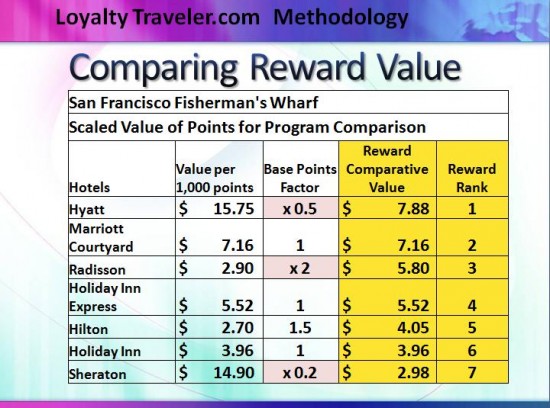
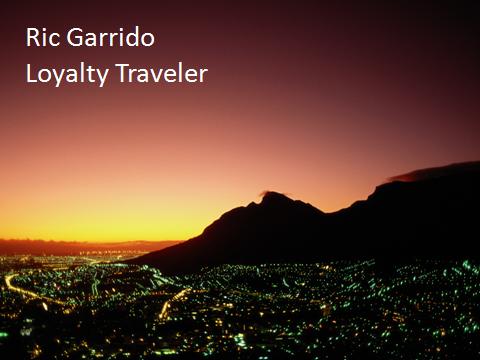

3 Comments
Comments are closed.